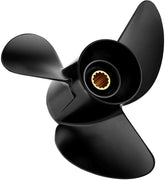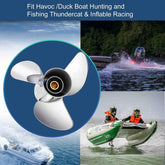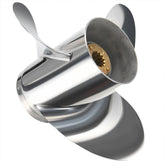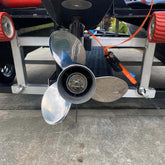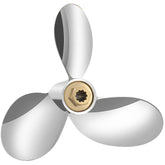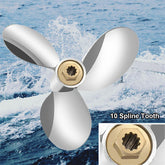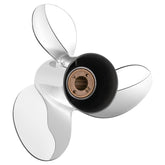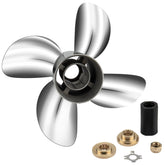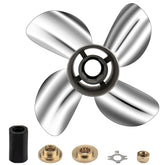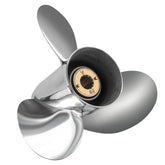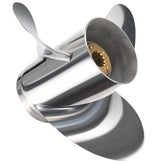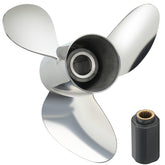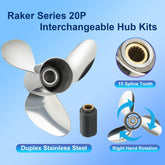Boat Propeller Guide: How Blade Count, Pitch and Material Change Real Performance
Choosing the right boat propeller is one of the most crucial decisions boat owners can make. Whether you're looking for better top-end speed, faster acceleration, or improved fuel efficiency, the blade count, pitch, and material of your propeller can dramatically affect your boat's performance. Here’s a comprehensive guide to understanding how these factors change real-world performance, and how you can choose the best propeller to match your needs.
If you’re new to buying boat propellers or need to browse our selection of high-quality options, visit our Boat Propeller Online Store to see the variety of products we offer, including options for propeller for Yamaha, propeller for MERCURY, and more.
Blade Count — What Changing Blades Actually Does on the Water
The Basics of Blade Count
Blade count is one of the first things boaters consider when choosing a propeller. A propeller with more blades typically provides better grip on the water, which is crucial for accelerating or pulling heavy loads. On the other hand, fewer blades reduce drag and are often preferred for higher speed applications. Understanding the impact of blade count can help you select the right one for your specific boating needs.
-
3-blade propeller: A 3-blade propeller is the most common choice for recreational boats. It offers a good balance between speed, acceleration, and fuel efficiency. These are particularly effective for smaller boats or those that prioritize top-end speed.
-
4-blade propeller: A 4-blade propeller is perfect for boats that need better low-speed control, such as pontoon boats or boats used for towing. The added blade provides more thrust, improving acceleration and reducing slip, especially when the boat is heavily loaded.
-
5-blade and specialty propellers: These are used for boats requiring even more smoothness and power, such as larger yachts or those used for commercial purposes. A 5-blade propeller provides smoother performance and reduces vibrations, especially in challenging water conditions.
When choosing the right propeller for your outboard motor, consider how you typically use your boat. For a general-purpose boat, a 3-blade propeller might be your best option, but for more controlled acceleration and towing, a 4-blade propeller might be necessary.
Pitch — The Primary Lever for Engine Placement and Performance
What Pitch Really Means
Pitch is defined as the theoretical distance a propeller would move forward in one complete revolution, assuming no slip occurs. The higher the pitch, the greater the distance the boat will travel with each revolution. This directly influences the boat's speed and engine RPM.
The Effect of Pitch on Boat Performance
-
Lower pitch: Lower pitch props are ideal for boats that need better acceleration or to work under load (like pontoons or towing boats). They provide more torque, allowing the engine to reach higher RPMs more easily, which is essential for getting the boat moving or towing large loads.
-
Higher pitch: A higher-pitched propeller is better suited for boats that prioritize speed over torque. These props allow the boat to travel further with each turn of the blades, improving top speed, but they can reduce acceleration.
If you're unsure which pitch to choose, it’s often best to start with a recommended pitch based on your boat’s specifications. For example, a propeller for Yamaha might start with a 13" pitch, and you can adjust based on your boat’s performance at wide-open throttle (WOT).
Material — Aluminum vs Stainless Steel
Aluminum Propellers
Aluminum is the most cost-effective material for boat propellers. It’s lightweight, making it easy to handle and install. Additionally, aluminum props are more resistant to minor impacts like rocks and debris, which is why they are often the go-to for casual boaters.
However, the main downside of aluminum is its softness. It can bend or get damaged more easily compared to stainless steel, especially under high RPMs or in saltwater environments.
For those who need to make quick repairs, propeller for Honda made from aluminum can be a more accessible option since small dents can often be repaired on the water.
Stainless Steel Propellers
Stainless steel propellers are much stiffer and offer superior performance. They allow for higher RPMs and are more durable than aluminum props, making them a better choice for high-performance boats or those used in harsh conditions.
While stainless steel props are more expensive upfront, they offer better efficiency, smoother performance, and longer life. For long-term boat owners or those in commercial applications, investing in stainless steel is often worthwhile.
Pitch, Blade Count, and Material — How They Work Together
When you understand how pitch, blade count, and material affect your boat's performance, you can see how they work together in harmony. For example:
-
For speed-focused boats: A 3-blade, stainless steel prop with a high pitch is often the best choice. It reduces drag and increases top-end speed, ideal for boats that need to perform in high-performance settings like racing or recreational cruising.
-
For towing and heavy-load boats: A 4-blade aluminum propeller with a lower pitch will allow for better acceleration and smoother control, making it ideal for pontoons, fishing boats, and boats used for watersports or towing.
Ultimately, you need to balance these three factors based on your specific needs, boating conditions, and performance expectations. If you need a starting point, check out our propeller for Suzuki or propeller for Volvo collections for tailored recommendations.
Maintenance and Care — Extending the Life of Your Boat Propeller
Regular maintenance is essential for maintaining the performance of your boat propeller. Here are some tips:
-
Inspect for damage: Regularly check your propeller for dings, dents, or corrosion. Even small imperfections can cause a significant drop in performance.
-
Clean after use: Wash your propeller with fresh water after every trip, especially if you’ve been in saltwater. This prevents corrosion and buildup of marine growth.
-
Consider carrying a spare: Always have a spare aluminum prop with you, especially on longer trips. These can be field-repaired if necessary, unlike stainless steel props.
For more details on maintaining or replacing your boat propeller, visit our How Boat Propellers Are Manufactured page.
Conclusion — Finding the Right Propeller for Your Boat
The right propeller is crucial for achieving the best performance for your specific boating needs. Whether you're looking for more speed, better acceleration, or improved fuel efficiency, understanding how blade count, pitch, and material affect performance will help you make an informed decision.
For a wider selection of boat propellers that fit various engines, browse our Boat Propeller Online Store or visit our hot-selling propellers page for our best-selling products like YBS, Chopper, and Vengeance propellers.


